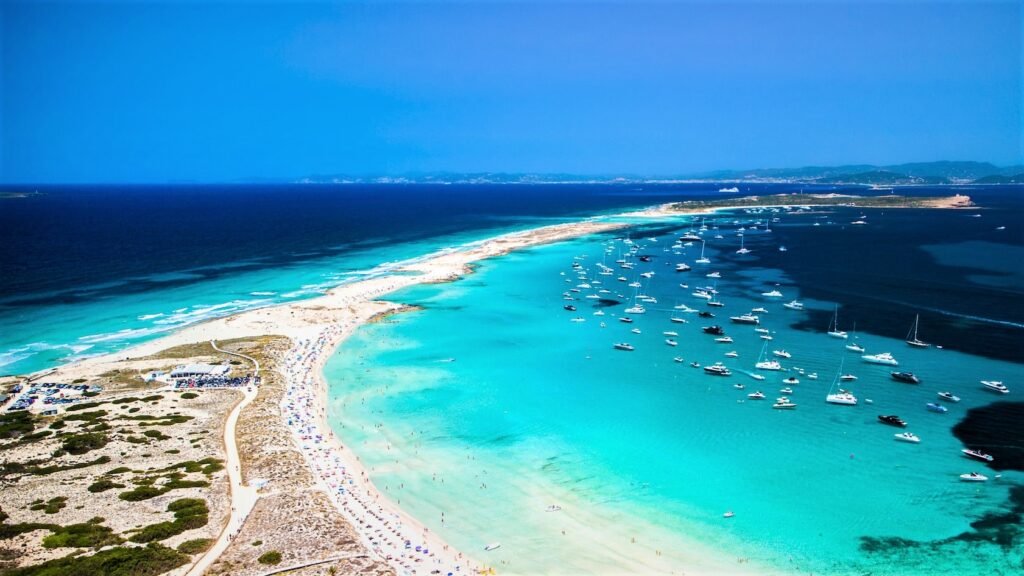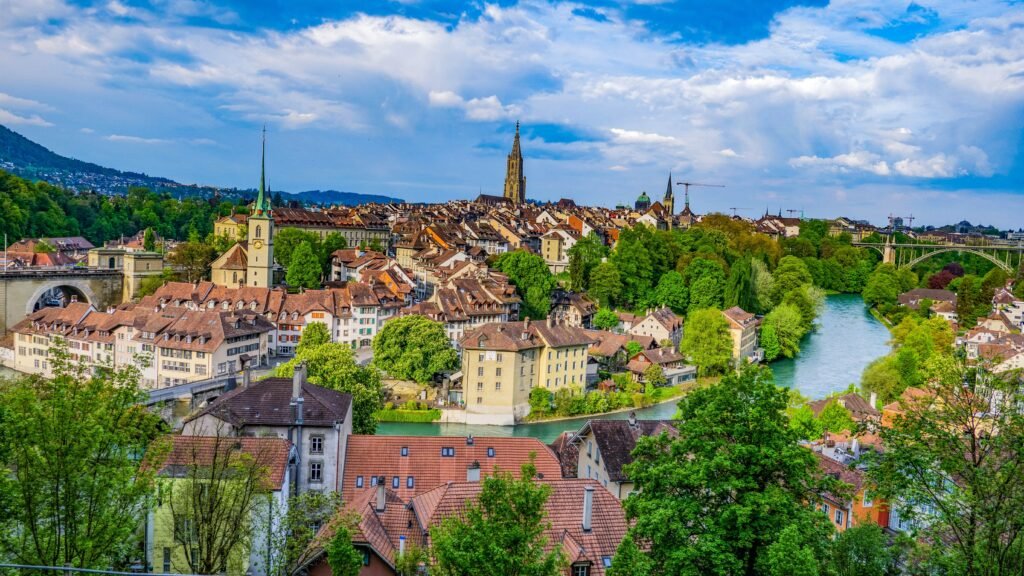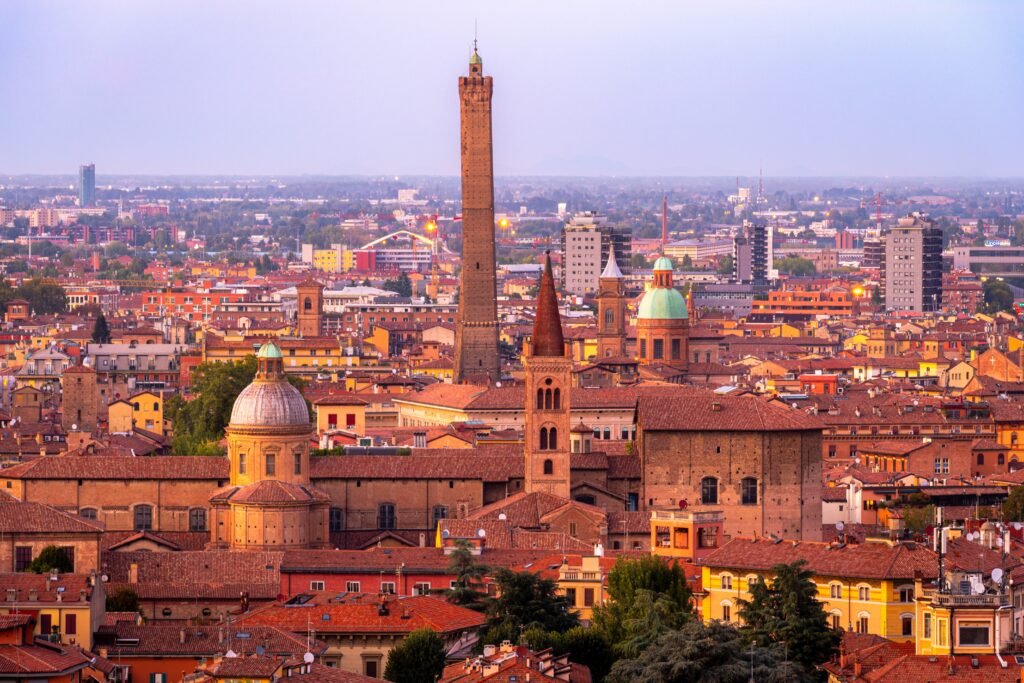Welcome to Formentera, a slice of paradise tucked away in the Balearic Islands of Spain. Known for its pristine beaches, turquoise waters, and laid-back atmosphere, Formentera is a hidden gem that beckons travelers seeking a tranquil and idyllic escape from the hustle and bustle of everyday life. As the smallest of the Balearic Islands, Formentera may be often overshadowed by its more famous neighbor, Ibiza. However, it is precisely this under-the-radar charm that makes Formentera a haven for those in search of a more authentic and unspoiled Mediterranean experience. If you are planning a trip to Formentera, look for flights and travel insurance
Table of Contents
The Allure of Formentera’s Beaches
The beaches of Formentera are the crown jewels of the island’s allure, drawing visitors from around the world with their pristine beauty and tranquil charm. Here’s more information about what makes these beaches so special:
- Diversity of Beaches: Formentera boasts a diverse range of beaches, each with its own unique characteristics. Whether you prefer long stretches of soft, powdery sand or secluded coves nestled between rocky cliffs, you’ll find a beach that suits your preference. Some of the most popular beaches include:

- Playa Illetas: Located on the northern tip of the island, Playa Illetas is often considered one of the most beautiful beaches in Europe. It features fine white sand, shallow turquoise waters, and a relaxed ambiance. The beach is surrounded by sand dunes and is part of the Ses Salines Natural Park.
- Playa Levante: This beach, also known as Ses Illetes, is another stunning option near Playa Illetas. It offers clear waters and beautiful views of the neighboring islets of S’Espalmador and Espardell.
- Cala Saona: Nestled in a sheltered cove on the western coast, Cala Saona is characterized by its picturesque cliffs and crystal-clear waters. The sunset views from this beach are simply magical.
- Playa Migjorn: Running along the southern coast of the island, Playa Migjorn is the longest beach on Formentera. It stretches for approximately 5 kilometers and is perfect for long walks and sunbathing.
- Pristine Waters: Formentera’s beaches are renowned for their incredibly clear and transparent waters. The combination of white sand and turquoise sea creates a mesmerizing palette of colors that seem almost unreal. Snorkeling and swimming in these crystal-clear waters offer a chance to explore the underwater world and observe the diverse marine life.
- Tranquil Atmosphere: Unlike some of the more bustling and party-centric beaches of its neighboring island, Ibiza, Formentera’s beaches exude a sense of tranquility and serenity. The island’s commitment to sustainable tourism has helped preserve its natural beauty and maintain a peaceful atmosphere, making it an ideal destination for those seeking a relaxing beach getaway.
- Beach Bars and Chiringuitos: While Formentera’s beaches remain unspoiled and uncrowded, you’ll still find charming beach bars (chiringuitos) scattered along the coastline. These laid-back establishments offer refreshments, delicious local cuisine, and a perfect spot to unwind while gazing at the sea.
- Nude Beaches: Formentera is also known for its acceptance of naturism, and there are designated nude beaches on the island. These areas provide a liberating and comfortable environment for those who wish to experience a clothing-optional beach experience.
Overall, Formentera’s beaches are a true paradise for beach lovers. Whether you’re looking to bask in the sun, swim in pristine waters, or simply enjoy the tranquility of the Mediterranean coastline, these stunning beaches offer a memorable and enchanting experience for all who visit.
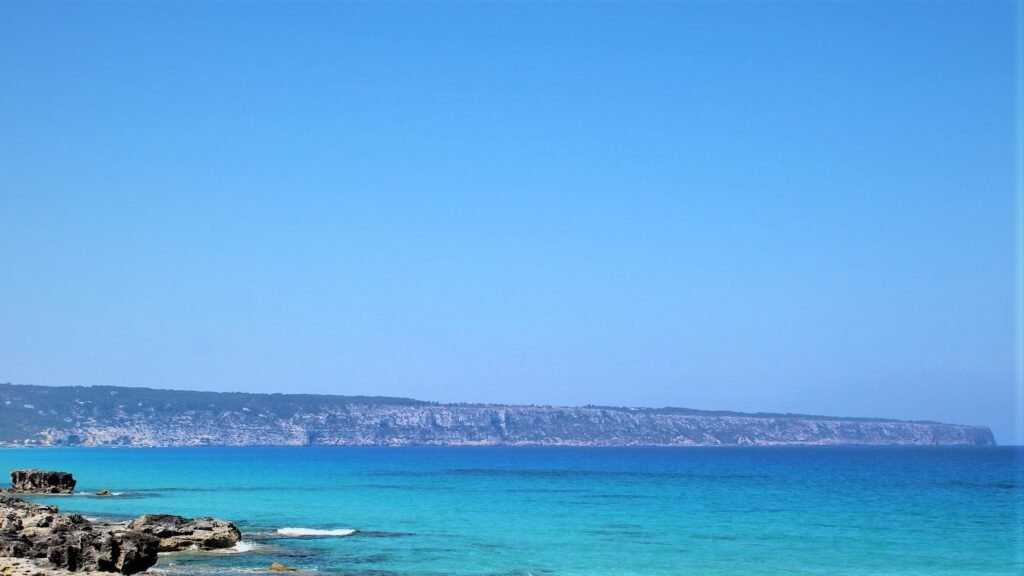
Eclectic Culture and Gastronomy
Formentera’s eclectic culture and gastronomy are influenced by its fascinating history, blending various cultural elements into a unique and delightful experience for visitors. Here’s more about these aspects of the island:
- Cultural Fusion: Formentera’s history is a tapestry woven with the influences of different civilizations. Over the centuries, the island has been inhabited by Phoenicians, Carthaginians, Romans, Vandals, Byzantines, Moors, and Catalans. Each group left its mark on the island, contributing to its rich cultural heritage.
- Phoenician and Roman Influence: Ancient ruins and archaeological sites bear witness to Formentera’s Phoenician and Roman past. The Roman Mausoleum in the town of La Mola is one such example, offering a glimpse into the island’s historical significance.
- Moorish Influence: During the Islamic rule in the 10th century, Formentera experienced a period of Moorish influence. While remnants of this era are less visible today, it is believed that the island’s agricultural practices and water management systems were influenced by the Moors.
- Catalan Heritage: The Catalan culture has had a significant impact on Formentera, as it does on other Balearic Islands. The local language, Catalan, is widely spoken, and traditional customs and festivals are celebrated throughout the year.

- Charming Villages: Formentera’s towns and villages are charmingly quaint, reflecting the island’s traditional architecture and laid-back lifestyle. Exploring these villages is like stepping back in time, with whitewashed houses adorned with colorful bougainvillea, narrow cobblestone streets, and lively town squares where locals and visitors gather.
- Sant Francesc Xavier: The island’s capital and main village, Sant Francesc Xavier, is a hub of activity. Here, you can find local shops, restaurants, and cultural attractions, such as the church of Sant Francesc Xavier and the Ethnological Museum.
- Sant Ferran de ses Roques: This village is known for its bohemian and artistic ambiance, attracting creative souls from all over the world. The town’s vibrant energy is particularly evident during the annual Sant Ferran Festival.
- Gastronomy of Formentera: Formentera’s gastronomy is a reflection of its Mediterranean location, with an emphasis on fresh and locally sourced ingredients. Seafood plays a prominent role in the island’s cuisine, but there are also plenty of other delicious dishes to savor. Some highlights include:
- Bullit de Peix: A traditional fisherman’s stew made with a variety of fish and potatoes, typically accompanied by aioli sauce. This hearty dish is a must-try to immerse yourself in the island’s culinary traditions.
- Paella: A Spanish classic, Formentera’s paella is often prepared with fresh seafood, capturing the essence of the Mediterranean Sea in a single dish.
- Sobrassada: A cured sausage made from minced pork, paprika, and other spices, typical of the Balearic Islands.
- Local Wine: Formentera is home to a small but growing wine industry, producing some delightful local wines that pair perfectly with the island’s cuisine.
- Festivals and Traditions: Throughout the year, Formentera comes alive with festivals and traditions that celebrate its culture and heritage. Festivals often involve music, dance, and processions, offering visitors a glimpse into the island’s vibrant spirit and sense of community.
- Festa de la Sal: Celebrated in February, this festival pays homage to the traditional salt production on the island, a practice dating back to Roman times. It includes music, dance, and demonstrations of salt extraction.
- La Mola Craft Market: Held every Wednesday and Sunday evening from May to October, this market showcases the work of local artisans, offering handmade crafts, jewelry, and clothing.
Formentera’s eclectic culture and gastronomy are a reflection of its diverse history and the natural beauty that surrounds it. Whether you’re exploring charming villages, indulging in delicious seafood dishes, or immersing yourself in local festivals, you’ll discover a deep sense of tradition and a warm welcome from the island’s residents.
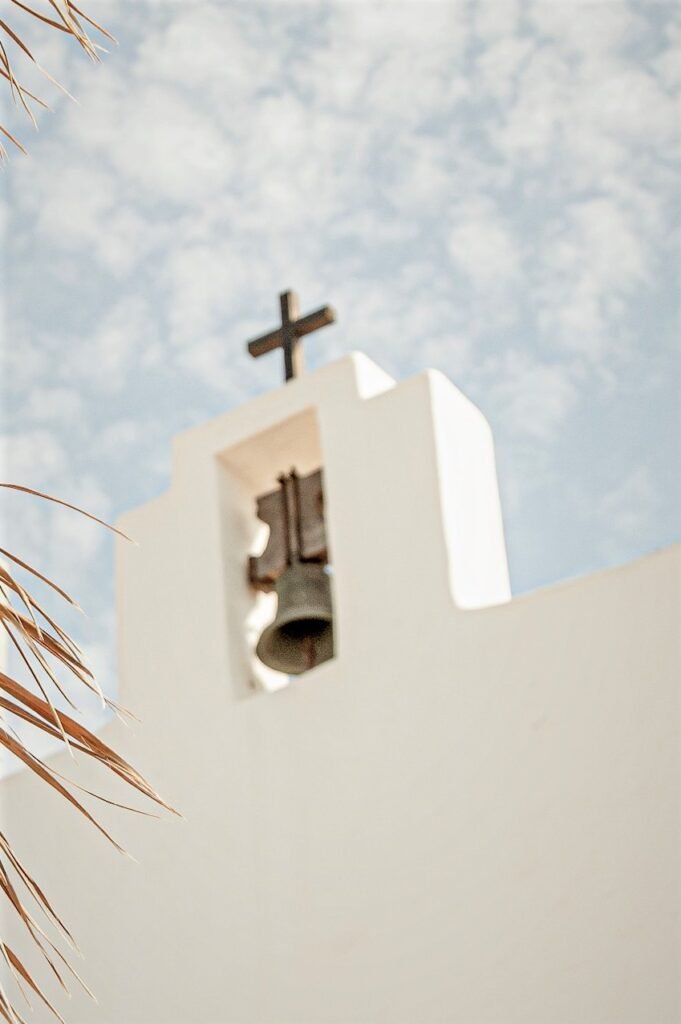
A Haven for Nature Lovers
Formentera is an idyllic paradise for nature lovers, offering a diverse range of landscapes and habitats to explore. Here’s why the island is a haven for those who appreciate the beauty of the natural world:
- Ses Salines Natural Park: Located in the northern part of Formentera, the Ses Salines Natural Park is a protected area that encompasses not only parts of the island but also the neighboring island of Ibiza. The park is named after the salt flats that have been an essential part of the island’s history and economy for centuries. Here, you can take leisurely walks along marked trails and observe a variety of bird species, including flamingos, herons, and various migratory birds. The unique ecosystem of the salt flats and wetlands makes it an ideal spot for birdwatching and nature photography.
- Pristine Beaches and Coves: While Formentera’s beaches are a major attraction for tourists, they also hold great appeal for nature enthusiasts. The island’s coastline is remarkably well-preserved, with many beaches and coves accessible only by foot or bike. Exploring these hidden gems allows you to immerse yourself in the untouched beauty of the Mediterranean coastline. As you venture away from the more popular beaches, you’ll discover secluded spots where you can bask in the tranquility of nature, surrounded by breathtaking landscapes.
- Hiking and Cycling Trails: Formentera’s small size and relatively flat terrain make it an excellent destination for hiking and cycling. There are various marked trails and paths that crisscross the island, leading you through picturesque countryside, pine forests, and coastal cliffs. Whether you’re an experienced hiker or a leisurely nature walker, the island offers routes suitable for all levels of fitness.
- Es Cap de Barbaria Lighthouse: Located on the southern tip of Formentera, the Es Cap de Barbaria Lighthouse is an iconic landmark that rewards visitors with stunning panoramic views of the surrounding landscape and the Mediterranean Sea. The area surrounding the lighthouse is rugged and wild, making it a great spot to connect with nature and enjoy the island’s natural beauty.
- Stargazing: Formentera’s commitment to preserving its natural environment extends to limiting light pollution, making it an excellent destination for stargazing. On clear nights, the skies above the island come alive with twinkling stars and constellations. Head to one of the less populated areas away from artificial light sources to enjoy an unforgettable celestial experience.
- Marine Life and Snorkeling: The crystal-clear waters that surround Formentera offer excellent opportunities for snorkeling and observing marine life. Grab your snorkeling gear and explore the underwater world teeming with colorful fish, vibrant corals, and other marine creatures. The marine reserves around the island are particularly well-protected, ensuring the preservation of the delicate marine ecosystem.

Formentera’s natural beauty and commitment to preserving its environment make it a haven for nature lovers. From its pristine beaches and diverse landscapes to its wildlife-rich areas and stargazing opportunities, the island offers an abundance of experiences for those seeking to connect with nature and revel in its wonders. Whether you’re exploring its natural parks, hiking its trails, or simply soaking in the beauty of its coastline, Formentera is sure to leave a lasting impression on nature enthusiasts.
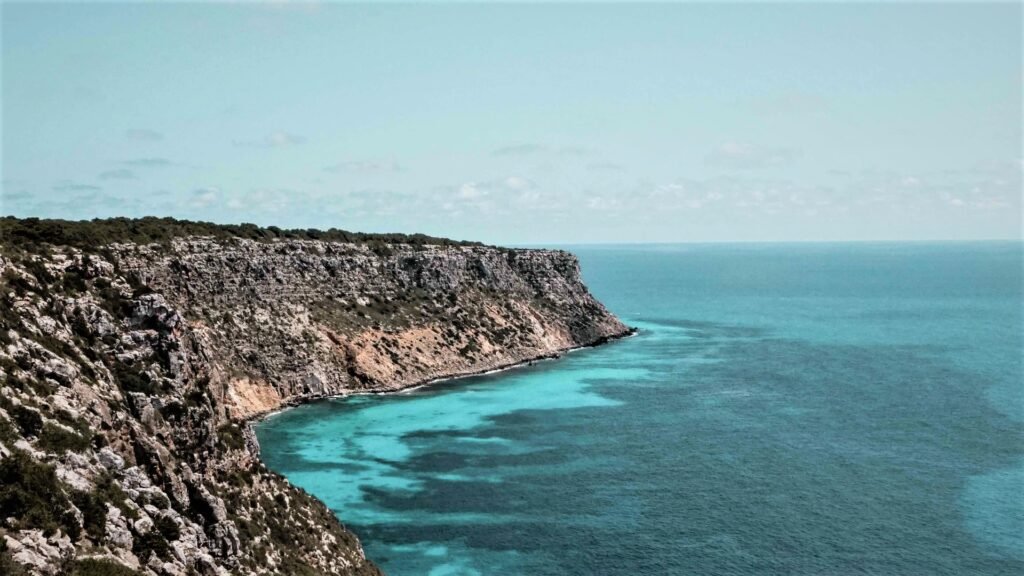
Embracing the Slow Pace of Life
Embracing the slow pace of life is an integral part of the Formentera experience. The island’s relaxed and unhurried atmosphere allows visitors to disconnect from the stresses of modern life and truly immerse themselves in the present moment. Here’s more about how Formentera encourages a slower, more mindful way of living:
- Relaxed Beach Life: Formentera’s stunning beaches are not just places to sunbathe and swim; they are havens for relaxation and contemplation. As you lounge on the soft sands or lie on a beach towel under the shade of an umbrella, you’ll feel the gentle sea breeze and hear the soothing sound of waves lapping against the shore. The slow rhythm of the ocean sets the tone for a leisurely day by the sea, where you can read a book, take a peaceful nap, or simply gaze out at the horizon.
- Siesta Tradition: Like the rest of Spain, Formentera embraces the tradition of the siesta—a midday break to rest and escape the heat of the day. Many shops and businesses close for a few hours in the early afternoon, encouraging locals and visitors alike to slow down, recharge, and enjoy a siesta before resuming their activities later in the day. This cultural practice embodies the island’s philosophy of taking time for relaxation and self-care.
- Biking and Scootering: Exploring Formentera at a slower pace is made easy by renting bicycles or scooters. With a limited number of cars on the island, these eco-friendly modes of transportation allow you to take in the natural beauty of the landscapes and coastline without the rush of traffic. Leisurely biking or scootering along the scenic routes offers an opportunity to fully appreciate the island’s tranquility and natural charm.
- Sunset Rituals: Sunsets on Formentera are nothing short of magical, and locals and visitors alike gather each evening to witness the spectacle. As the sun sets over the horizon, the sky is painted in hues of orange, pink, and purple, creating a breathtaking panorama. The slower pace of life on the island allows people to pause and savor these fleeting moments, embracing the beauty of nature’s daily spectacle.
- Connection with Nature: Formentera’s unspoiled nature and commitment to sustainability encourage visitors to connect with the environment on a deeper level. Whether it’s strolling through nature reserves, swimming in crystal-clear waters, or walking along coastal trails, being in tune with nature helps people slow down and appreciate the simple pleasures that the island offers.
- Savoring Local Cuisine: In Formentera, meals are not just about nourishment but also an opportunity to savor local flavors and engage in meaningful conversations. Dining at a leisurely pace, trying regional dishes, and sharing meals with friends and family are central to the island’s culture. The act of sitting down for a relaxed meal is seen as a moment of connection and enjoyment rather than merely satisfying hunger.
Formentera’s slow pace of life is an integral part of the island’s charm. It encourages visitors to take a step back, unwind, and appreciate the beauty of simplicity. Whether it’s embracing siestas, leisurely exploring the island, or immersing oneself in the natural wonders, Formentera offers a unique opportunity to slow down and embrace the art of living in the moment.
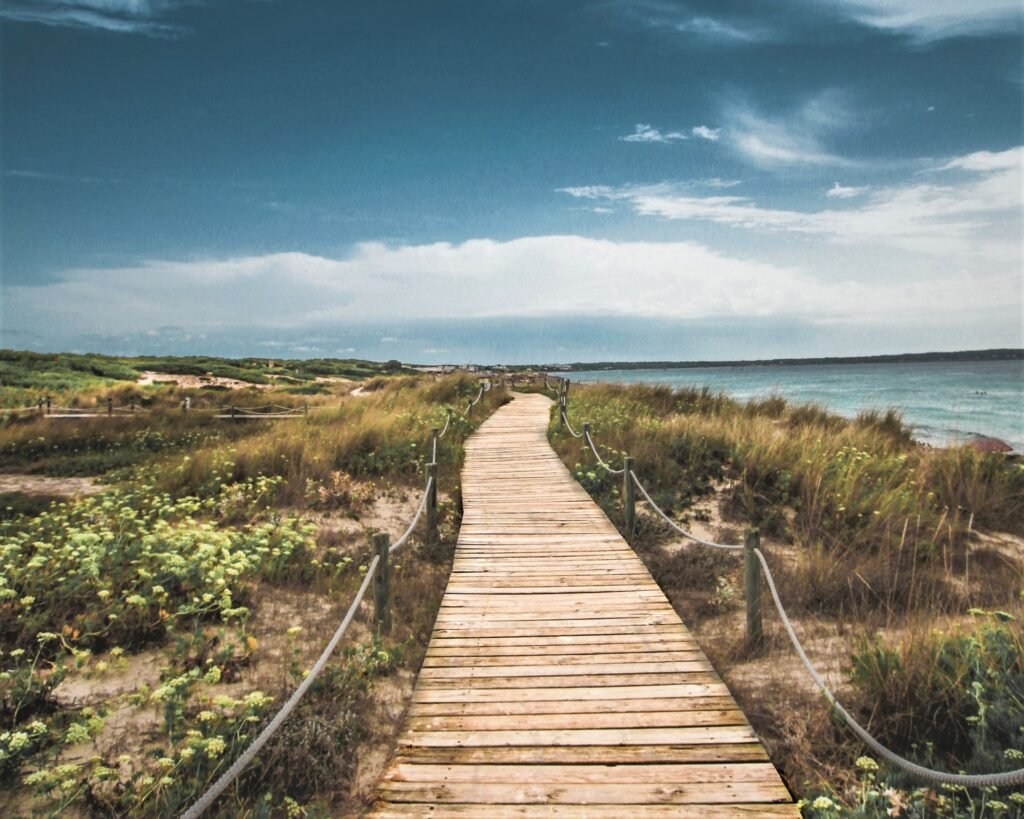
Sustainable Tourism and Preservation
Sustainable tourism and preservation are core principles that Formentera has adopted to protect its natural beauty and ensure the well-being of the island’s ecosystem. Here’s a closer look at how Formentera prioritizes sustainable practices and environmental preservation:
- Responsible Tourism Management: Formentera is committed to managing tourism in a responsible and sustainable manner. Local authorities work closely with businesses, residents, and visitors to minimize the negative impacts of tourism on the island’s environment and culture. Measures are put in place to control the number of tourists, limit construction in sensitive areas, and promote sustainable development.
- Limited Development and Low-Impact Infrastructure: Unlike many other tourist destinations, Formentera has kept its development in check to preserve the island’s natural charm. High-rise buildings and large hotels are limited, and most accommodations consist of smaller hotels, guesthouses, and vacation rentals that blend harmoniously with the landscape. The island’s low-impact infrastructure helps maintain the balance between tourism and nature.
- Renewable Energy and Waste Management: Formentera is striving to become more self-sufficient in terms of energy consumption. Renewable energy sources such as solar and wind power are harnessed to meet the island’s energy needs. Additionally, there is a focus on waste management and recycling to reduce the environmental impact of tourism.
- Protection of Marine Life: The surrounding waters of Formentera are part of the Posidonia Oceanica UNESCO World Heritage site. Posidonia seagrass meadows play a crucial role in maintaining marine biodiversity and protecting coastlines from erosion. To safeguard this unique ecosystem, the island enforces regulations to protect marine life, including restrictions on anchoring and boating in specific areas.
- Promotion of Eco-Friendly Transportation: To reduce carbon emissions and limit traffic congestion, Formentera encourages the use of eco-friendly transportation options. Bicycles and scooters are popular choices for getting around the island, and there are extensive bike lanes and bike rental services available. The island also promotes the use of electric vehicles for local transportation.
- Sustainable Agriculture and Local Produce: Formentera supports sustainable agriculture practices and promotes the consumption of locally sourced produce. Many restaurants and eateries on the island use fresh, organic ingredients from local farmers and fishermen, reducing the carbon footprint of the food supply chain.
- Environmental Education and Awareness: To foster a culture of environmental consciousness, Formentera actively engages in environmental education and awareness campaigns. Local organizations and authorities conduct workshops, seminars, and awareness programs to educate residents and visitors about the importance of preserving the island’s natural resources.

Formentera’s commitment to sustainable tourism and preservation sets an example for responsible travel practices. By prioritizing eco-friendly initiatives, limiting overdevelopment, and promoting conservation efforts, the island aims to protect its pristine beauty and unique ecosystems for generations to come. Visitors to Formentera are encouraged to join in these efforts by embracing responsible tourism practices and leaving behind only footprints while taking away cherished memories of this unspoiled Mediterranean paradise.

Formentera may be small in size, but its allure is boundless. A true paradise for beach lovers and nature enthusiasts, the island offers an unparalleled escape from the stresses of modern life. Whether you’re seeking relaxation on pristine beaches, a taste of authentic Mediterranean culture, or a chance to connect with nature, Formentera has it all. So, if you’re yearning for a tranquil and enchanting getaway, Formentera should be at the top of your travel bucket list. Unwind, rejuvenate, and embrace the magic of this captivating island, and you’ll leave with unforgettable memories and a longing to return.
Check out all our blogs.
